SUPPLY and DEMAND
The previous midterm tested the introductory supply and and
demand material. For this test, you should be able to use the graph.
ELASTICITY AND ITS APPLICATION
- the meaning of the elasticity of demand.
- what determines the elasticity of demand.
- the concept of elasticity in three very different markets (the market for
wheat, the market for oil, and the market for illegal drugs). We did not
cover all of these examples, but they are good and worth reviewing.
KEY POINTS:
The price elasticity of demand measures how much the quantity demanded
responds to changes in the price. Demand tends to be more elastic if the good
is a luxury rather than a necessity, if close substitutes are available, if
the market is narrowly defined, or if buyers have substantial time to react to
a price change.
The price elasticity of demand is calculated as the percentage change in
quantity demanded divided by the percentage change in price. If the elasticity
is less than one, so that quantity demanded moves proportionately less than
the price, demand is said to be inelastic. If the elasticity is greater than
one, so that quantity demanded moves proportionately more than the price,
demand is said to be elastic.
Total revenue, the total amount paid for a good, equals the price of the
good times the quantity sold. For inelastic demand curves, total revenue rises
as price rises. For elastic demand curves, total revenue falls as price rises.
Determinants of Price Elasticity of Demand
Necessities versus Luxuries: necessities are more price inelastic.
Availability of Close Substitutes: the more substitutes a good has, the
more elastic its demand.
Definition of the Market: narrowly defined markets (ice cream) have more
elastic demand than broadly defined markets (food).
Time Horizon: goods tend to have more elastic demand over longer time
horizons.

Example: price of ice cream rises by 10% and quantity demanded falls by 20%.
Price elasticity of demand = (20%)/(10%) = 2
CAN YOU DO THE MIDPOINT METHOD!!!!!
When the elasticity is greater than one, the demand is considered to be
elastic.
When the elasticity is less than one, the demand is considered to be
inelastic.

Definition of Total Revenue: the amount paid by buyers and received
by sellers of a good, computed as the price of the good times the quantity sold.
If demand is inelastic, the change in price will be greater than the
change in quantity demanded.
- If price rises, quantity demanded falls, and total revenue will rise
(because the increase in price was larger than the decrease in
quantity demanded).
- If price falls, quantity demanded rises, and total revenue will fall
(because the fall in price was larger than the increase in quantity
demanded).
Example: Why Did OPEC Fail to Keep the Price of Oil High?
Example: Does Drug Interdiction Increase or Decrease Drug-Related Crime?
SUPPLY, DEMAND, AND GOVERNMENT POLICIES
the effects of government policies that place a ceiling on prices.
- the effects of government policies that put a floor under prices.
- how a tax on a good affects the price of the good and the quantity sold.
- that taxes levied on buyers and taxes levied on sellers are equivalent.
- how the burden of a tax is split between buyers and sellers.
KEY POINTS:
- A price ceiling is a legal maximum on the price of a good or service. An
example is rent control. If the price ceiling is below the equilibrium
price, the quantity demanded exceeds the quantity supplied. Because of the
resulting shortage, sellers must in some way ration the good or service
among buyers.
- A price floor is a legal minimum on the price of a good or service. An
example is the minimum wage. If the price floor is above the equilibrium
price, the quantity supplied exceeds the quantity demanded. Because of the
resulting surplus, buyers’ demands for the good or service must in some
way be rationed among sellers.
- When the government levies a tax on a good, the equilibrium quantity of
the good falls. That is, a tax shrinks the size of the market.
- A tax on a good places a wedge between the price paid by buyers and the
price received by sellers. When the market moves to the new equilibrium,
buyers pay more for the good and sellers receive less for it. In this sense,
buyers and sellers share the tax burden. the incidence of a tax does not
depend on whether the tax is levied on buyers or sellers.
- The incidence of a tax depends on the price elasticities of supply and
demand. The burden tends to fall on the side of the market that is less
elastic because that side of the market can respond less easily to the tax
by changing the quantity bought or sold.
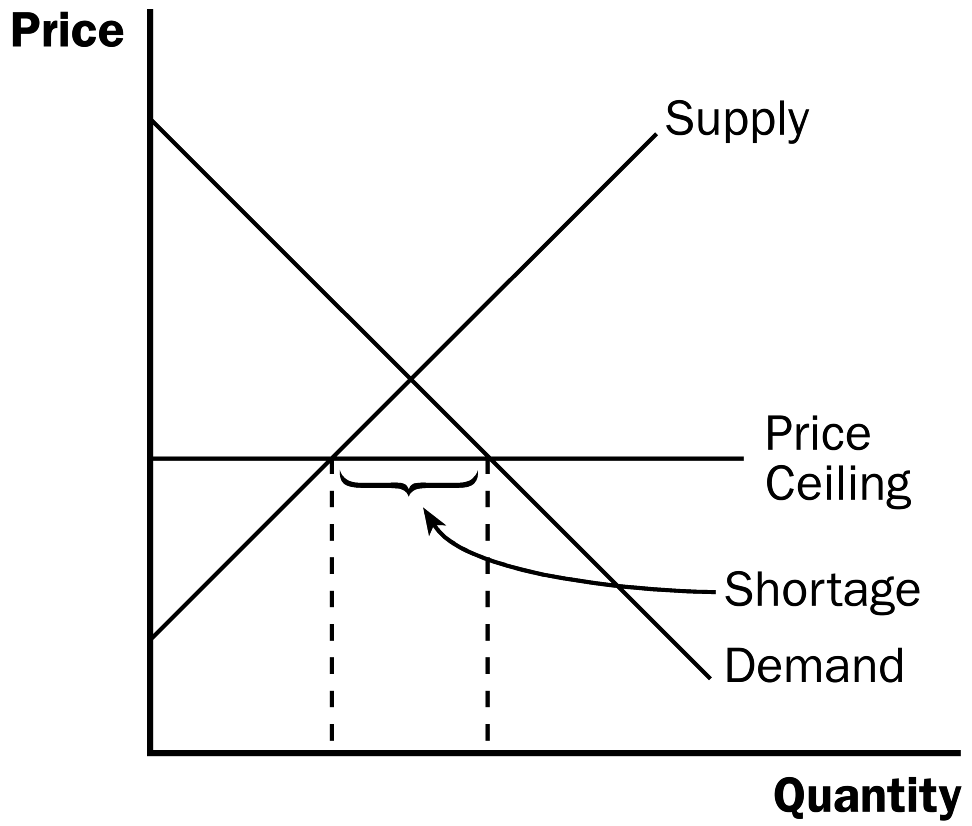
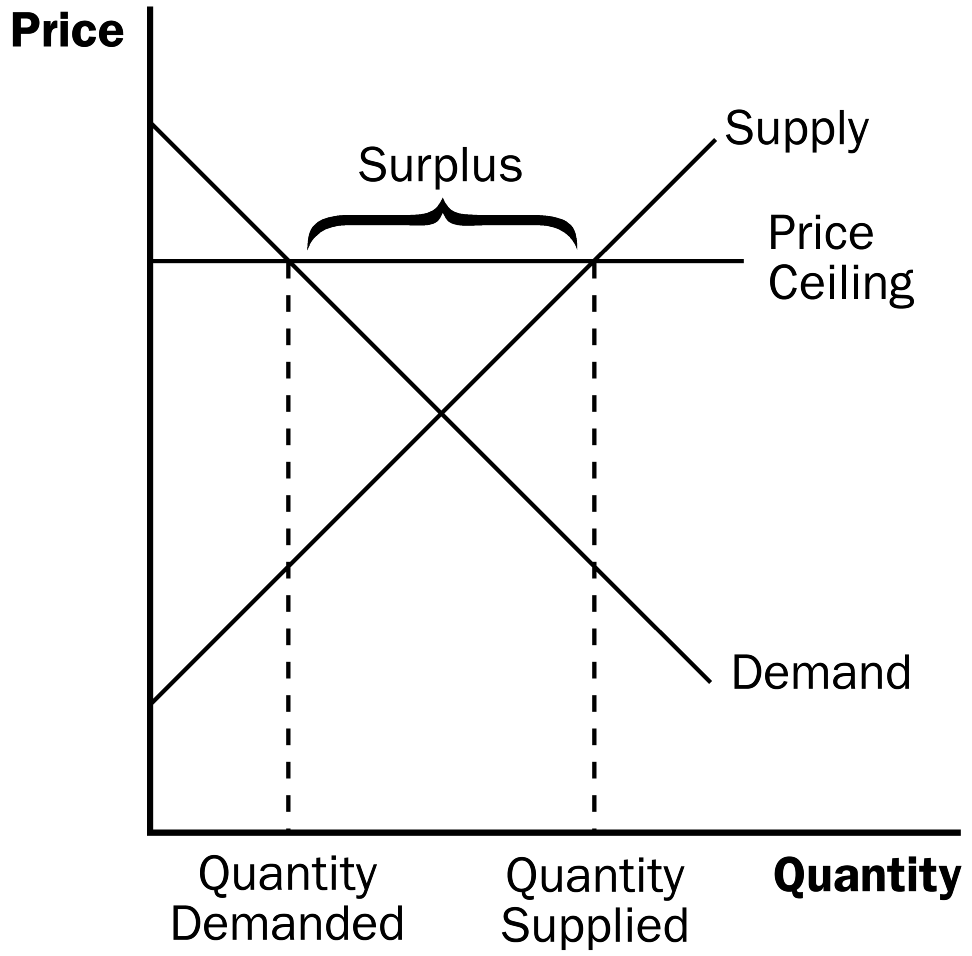
Oops! That should say price
floor, but I cannot change it now!
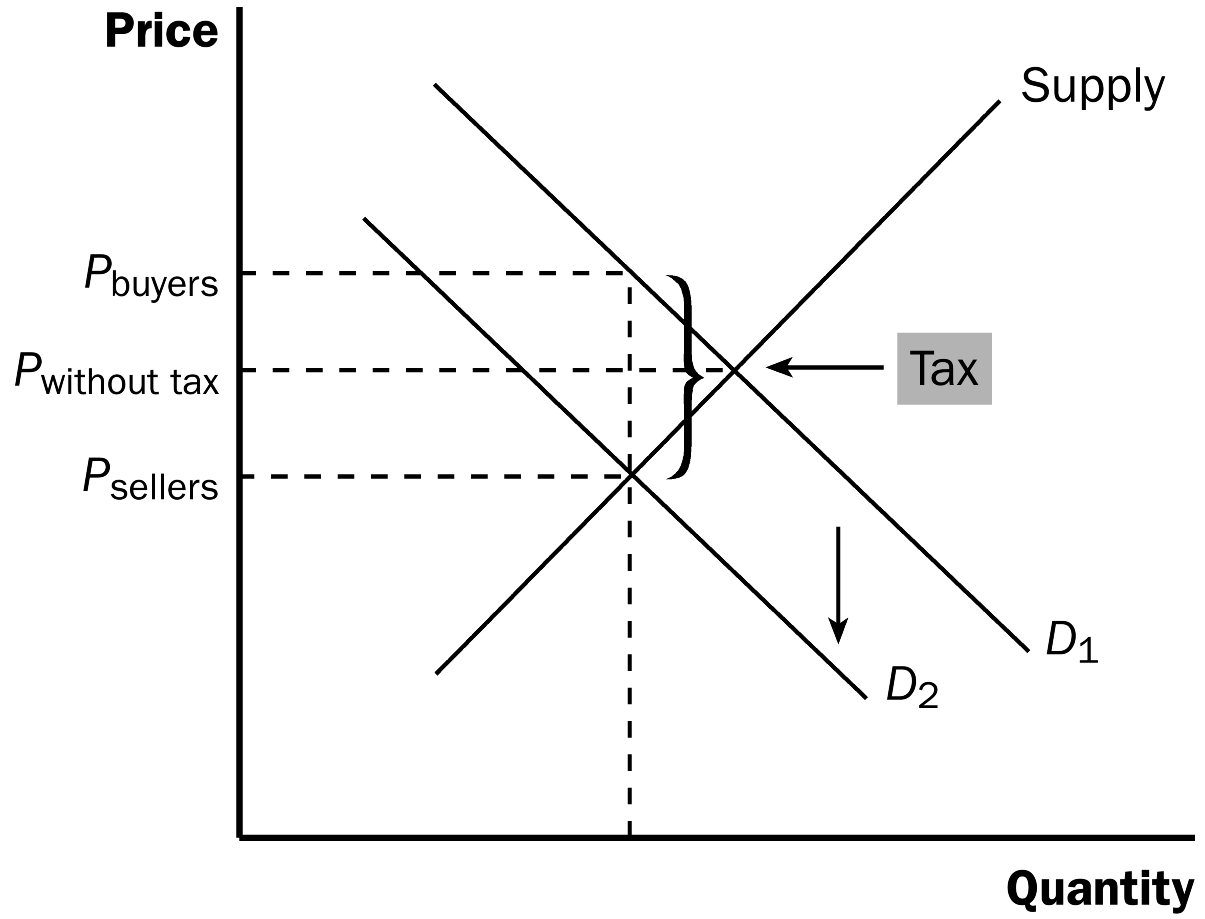
Know at least one real world example of each policy!
CONSUMERS, PRODUCERS, AND EFFICIENCY OF MARKETS
You should understand:
- the link between buyers’ willingness to pay for a good and the demand
curve.
- how to define and measure consumer surplus.
- the link between sellers’ costs of producing a good and the supply
curve.
- how to define and measure producer surplus.
- that the equilibrium of supply and demand maximizes total surplus in a
market.
KEY POINTS:
- Consumer surplus equals buyers’ willingness to pay for a good minus the
amount they actually pay for it, and it measures the benefit buyers get from
participating in a market. Consumer surplus can be computed by finding the
area below the demand curve and above the price.
- Producer surplus equals the amount sellers receive for their goods minus
their costs of production, and it measures the benefit sellers get from
participating in a market. Producer surplus can be computed by finding the
area below the price and above the supply curve.
- An allocation of resources that maximizes the sum of consumer and producer
surplus is said to be efficient. Policymakers are often concerned with the
efficiency, as well as the equity, of economic outcomes.
- The equilibrium of supply and demand maximizes the sum of consumer and
producer surplus. That is, the invisible hand of the marketplace leads
buyers and sellers to allocate resources efficiently.
- Markets do not allocate resources efficiently in the presence of market
failures such as market power or externalities.
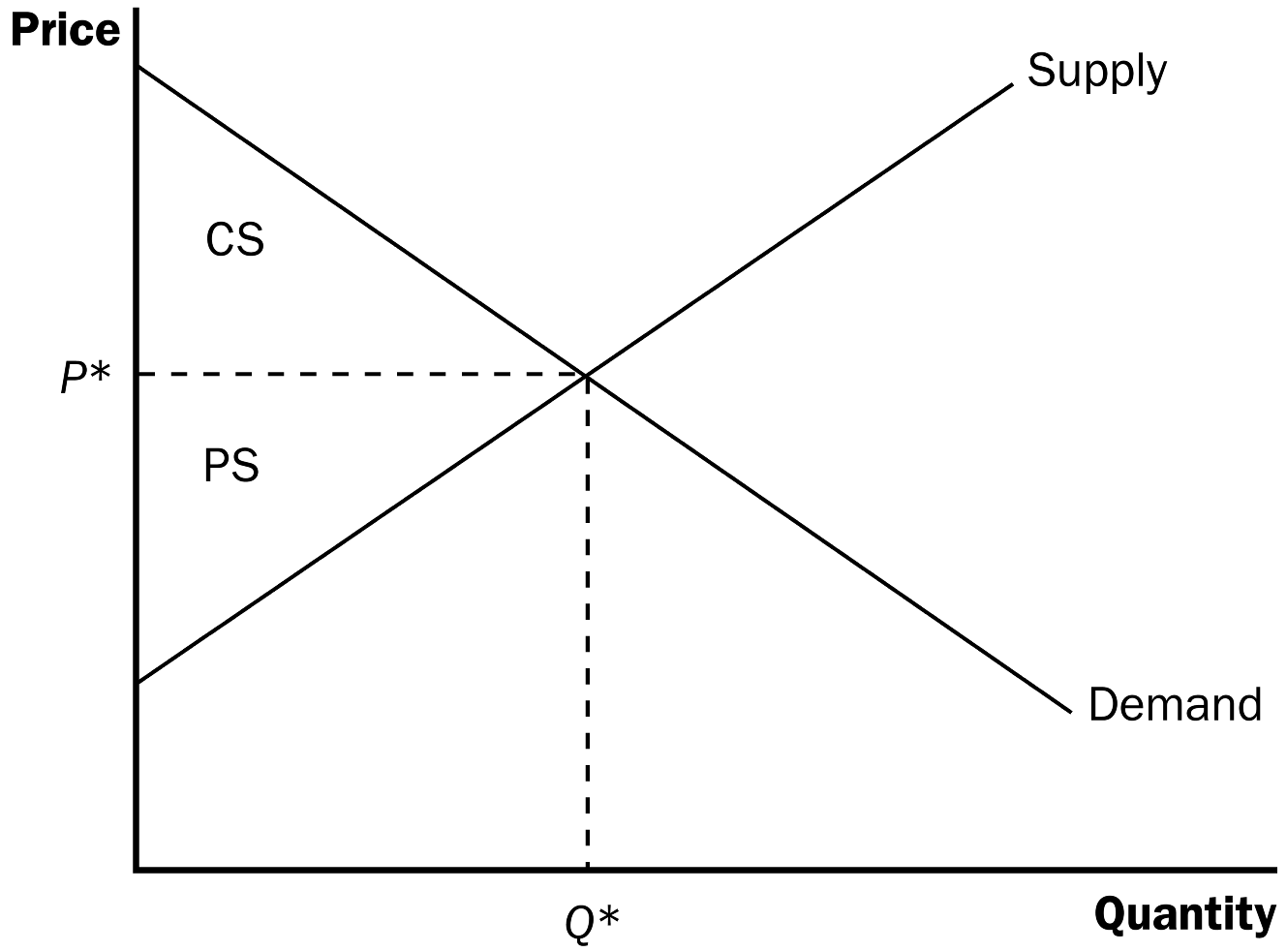
APPLICATION: THE COSTS OF TAXATION
You should understand:
- how taxes reduce consumer and producer surplus.
- the meaning and causes of the deadweight loss from a tax.
- why some taxes have larger deadweight losses than others.
- how tax revenue and deadweight loss vary with the size of a tax.
KEY POINTS:
- A tax on a good reduces the welfare of buyers and sellers of the good, and
the reduction in consumer and producer surplus usually exceeds the revenue
raised by the government. The fall in total surplus – the sum of consumer
surplus, producer surplus, and tax revenue — is called the deadweight loss
of the tax.
- Taxes have deadweight losses because they cause buyers to consume less and
sellers to produce less, and this change in behavior shrinks the size of the
market below the level that maximizes total surplus. Because the
elasticities of supply and demand measure how much market participants
respond to market conditions, larger elasticities imply larger deadweight
losses.
- As a tax grows larger, it distorts incentives more, and its deadweight
loss grows larger. Tax revenue first rises with the size of a tax.
Eventually, however, a larger tax reduces tax revenue because it reduces the
size of the market.
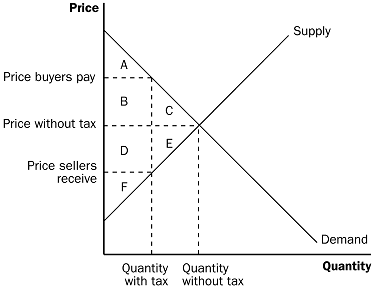
Welfare Before a Tax
a. Consumer surplus is equal to: A + B + C.
b. Producer surplus is equal to: D + E + F.
c. Total surplus is equal to: A + B + C + D + E + F.
Welfare with Tax
a. Consumer surplus is equal to: A.
b. Producer surplus is equal to: F.
c. Tax revenue is equal to: B + D.
d. Total surplus plus tax is equal to: A + B + D + F.
Definition of Deadweight Loss: the fall in total surplus that
results from a market distortion, such as a tax.

When demand is relatively inelastic, the deadweight loss is
small.
When demand is relatively elastic, the deadweight loss is
large.
As taxes increase, the deadweight loss from the tax increases.
In fact, as taxes increase, the deadweight loss rises more quickly
than the size of the tax.
Costs
You should understand:
- what items are included in a firm’s costs of production.
- the link between a firm’s production process and its total costs.
- the meaning of average total cost and marginal cost and how they are
related.
- the shape of a typical firm’s cost curves.
- the relationship between short-run and long-run costs.
KEY POINTS:
- The goal of firms is to maximize profit, which equals total revenue minus
total cost.
- When analyzing a firm’s behavior, it is important to include all the
opportunity costs of production. Some of the opportunity costs, such as the
wages a firm pays its workers, are explicit. Other opportunity costs, such
as the wages the firm owner gives up by working in the firm rather than
taking another job, are implicit.
- A firm’s costs reflect its production process. A typical firm’s
production function gets flatter as the quantity of an input increases,
displaying the property of diminishing marginal product. As a result, a firm’s
total-cost curve gets steeper as the quantity produced rises.
- A firm’s total costs can be divided between fixed costs and variable
costs. Fixed costs are costs that do not change when the firm alters the
quantity of output produced. Variable costs are costs that do change when
the firm alters the quantity of output produced.
- From a firm’s total cost, two related measures of cost are derived.
Average total cost is total cost divided by the quantity of output. Marginal
cost is the amount by which total cost would rise if output were increased
by one unit.
- When analyzing firm behavior, it is often useful to graph average total
cost and marginal cost. For a typical firm, marginal cost rises with the
quantity of output. Average total cost first falls as output increases and
then rises as output increases further. The marginal-cost curve always
crosses the average-total-cost curve at the minimum of average total cost.
- A firm’s costs often depend on the time horizon being considered. In
particular, many costs are fixed in the short run but variable in the long
run. As a result, when the firm changes its level of production, average
total cost may rise more in the short run than in the long run.
I. What Are Costs?
A. Total Revenue, Total Cost, and Profit
1. Goal of a firm: to maximize profit.
2. Definition of Tota1 Revenue: the amount a firm
receives for the sale of its output.

3. Definition of Total Cost: the market value of the
inputs a firm uses in production.
4. Definition of Profit: total revenue minus total
cost.

B. Costs as Opportunity Costs
1. Principle #2: The cost of something is what you give up to
get it.
2. The costs of producing an item must include all of the
opportunity costs of inputs used in production.
3. Total opportunity costs include both implicit and explicit
costs.
II. Production and Costs
A. The Production Function
1. Definition of Production Function: the
relationship between quantity of inputs used to make a good and
the quantity of output of that good.
2. Definition of Marginal Product: the increase in
output that arises from an additional unit of input.

a. As the amount of labor used increases, the marginal
product of labor falls.
Definition of Diminishing Marginal Product: the
property whereby the marginal product of an input declines as
the quantity of the input increases.
3. We can draw a graph of the firm’s production function by
plotting the level of labor (x-axis) against the level of output
(y-axis). This is the basic example.

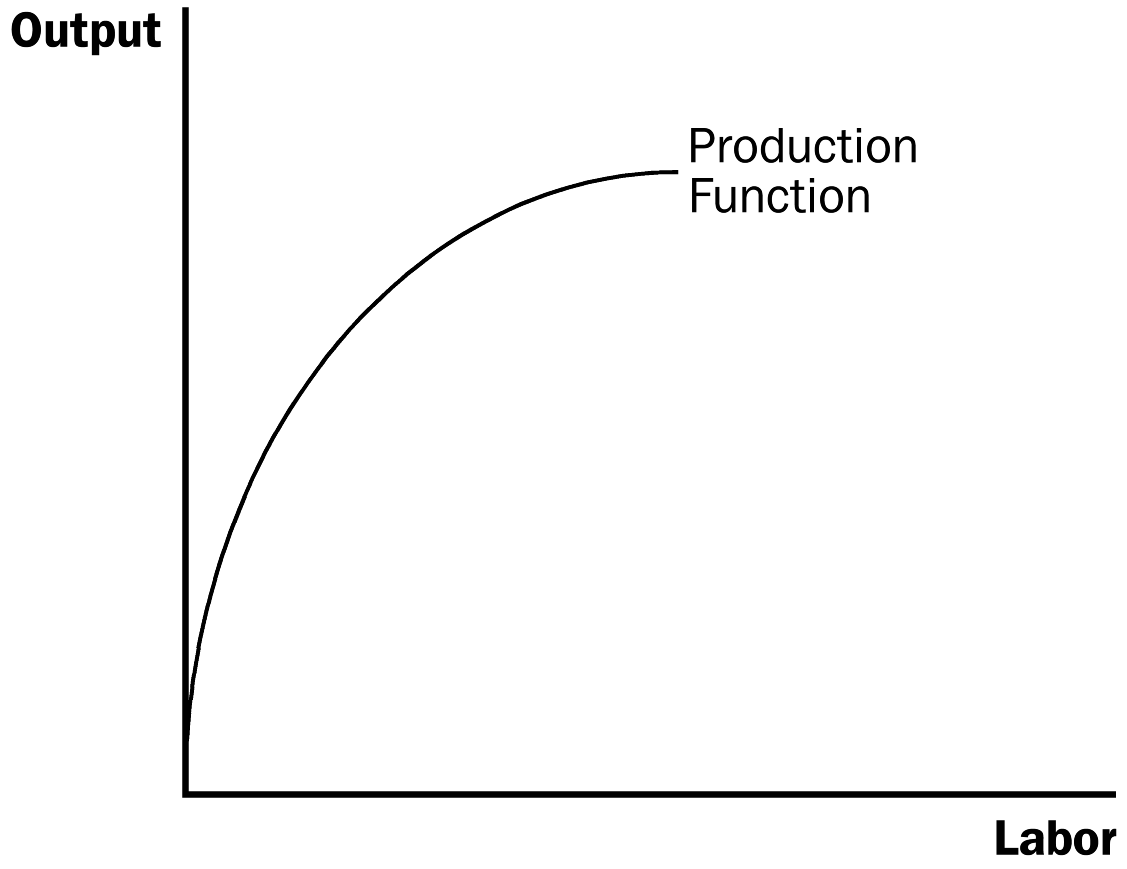
a. The slope of the production function measures marginal
product.
b. Diminishing marginal product can be seen from the fact
that the slope falls as the amount of labor used increases.
B. From the Production Function to the Total-Cost Curve
1. We can draw a graph of the firm’s total cost curve by
plotting the level of output (x-axis) against the total cost of
producing that output (y-axis). Again, this is the basic
graph.
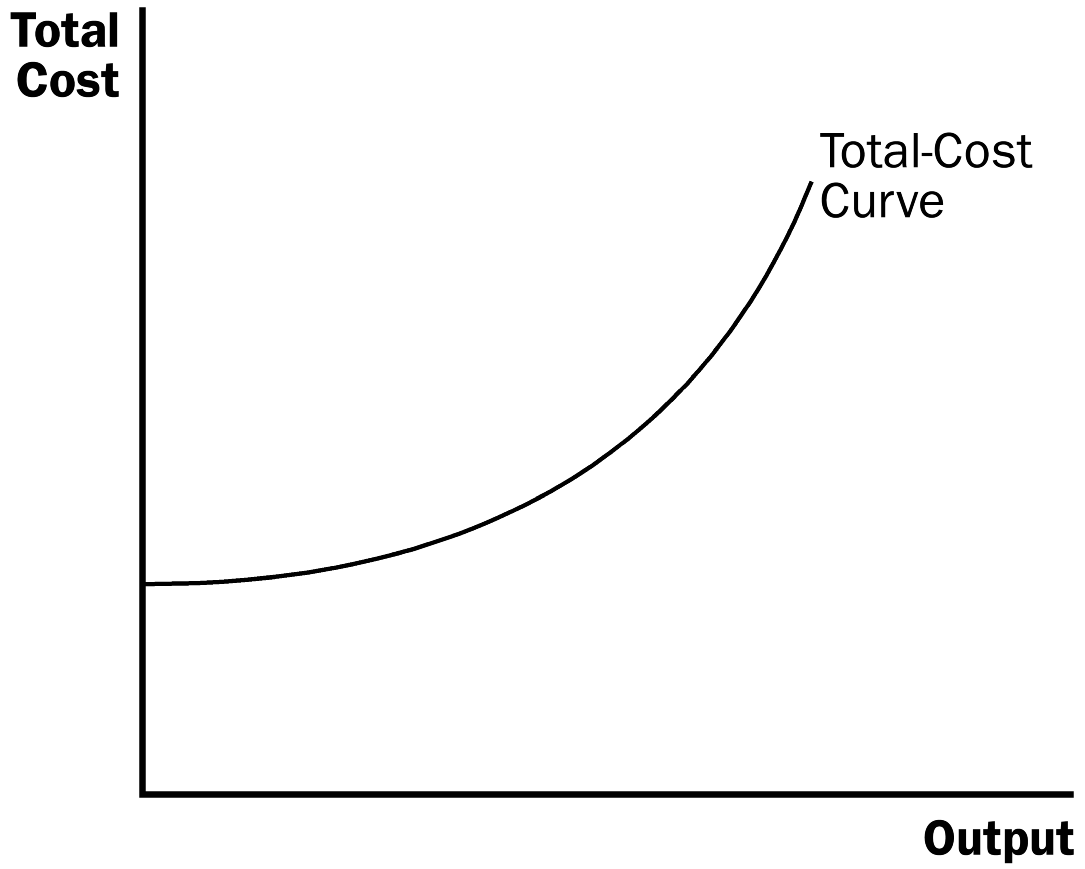
a. The total cost curve gets steeper and steeper as output
rises.
b. This increase in the slope of the total cost curve is
also due to diminishing marginal product: As Helen increases
the production of cookies, she needs more labor and her
kitchen becomes overcrowded.
III. The Various Measures of Cost
A. Fixed and Variable Costs
1. Definition of Fixed Costs: costs that do not vary
with the quantity of output produced.
2. Definition of Variable Costs: costs that do vary
with the quantity of output produced.
B. Average and Marginal Cost
1. Definition of Average Total Cost: total cost
divided by the quantity of output.
2. Definition of Average Fixed Cost: fixed costs
divided by the quantity of output.
3. Definition of Average Variable Cost: variable
costs divided by the quantity of output.
4. Definition of Marginal Cost: the increase in total
cost that arises from an extra unit of production.


5. Rising Marginal Cost
a. This occurs because of diminishing marginal product.
b. At a low level of output, there are few workers and a
lot of idle equipment. But as output increases, the lemonade
stand (or factory) gets crowded and the cost of producing
another unit of output becomes high.
6. U-Shaped Average Total Cost
a. Average total cost is the sum of average fixed cost and
average variable cost.

b. AFC declines as output expands and AVC increases as
output expands. AFC is high when output levels are low. As
output expands, AFC declines pulling ATC down. As fixed costs
get spread over a large number of units, the effect of AFC on
ATC falls and ATC begins to rise because of diminishing
marginal product.
4. Typical Cost Curves

a. Marginal cost eventually rises with output.
b. The average total cost curve is U-shaped.
c. Marginal cost crosses average total cost at the minimum
of the average total cost.
![]()







![]()

